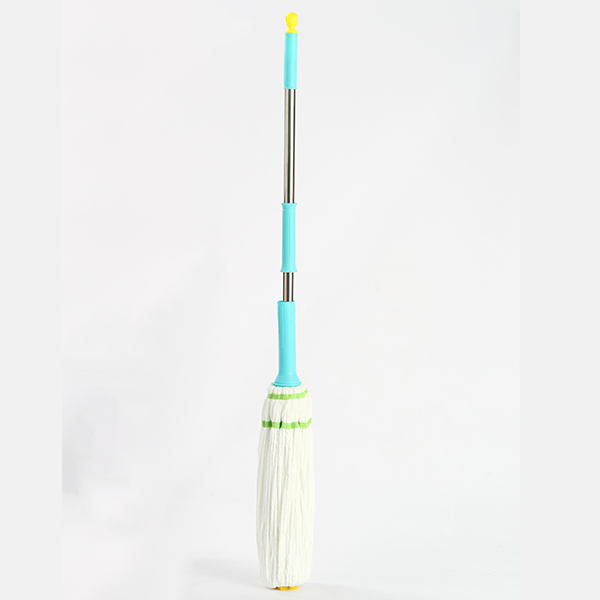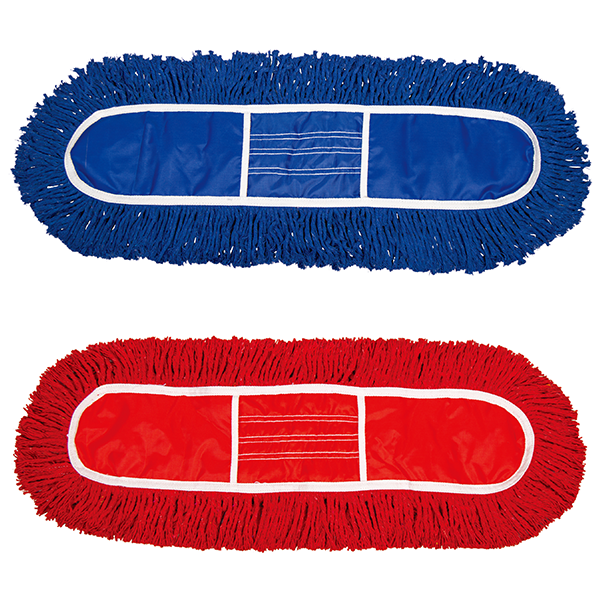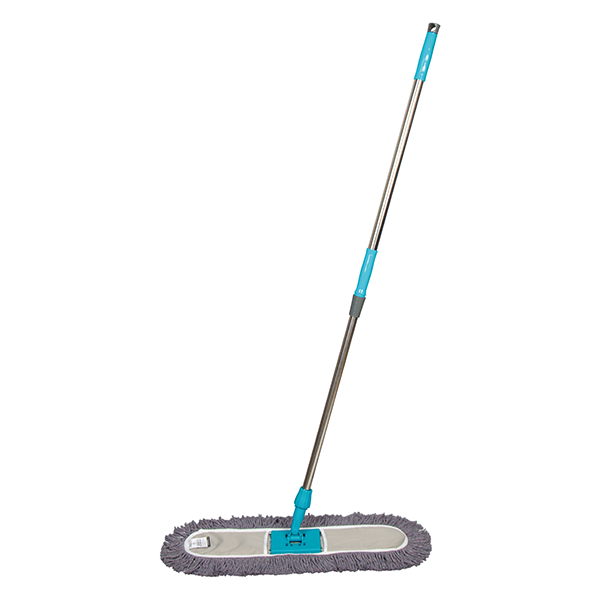How to Use a Twisting Mop?
A twisting mop works by using a wringer to squeeze out excess water from the mop head. The mop head is made of absorbent materials like cotton or microfiber, which are capable of picking up dirt and moisture from floors.
The wringer mechanism typically consists of a bucket with a wringer attached to the top. The wringer is usually made up of two rollers that squeeze the mop head between them to remove the excess water.
Some models have foot pedals or hand cranks that activate the wringer, while others have a built-in mechanism that automatically wrings out the mop as it is lifted from the bucket.
How to Use a Twisting Mop?
To use a twisting mop, the mop head is first dipped into a bucket filled with cleaning solution or water. The mop is then wrung out using the wringer, which removes excess moisture and makes the mop damp enough to effectively clean the floor. The mop head is then used to clean the floor by sweeping it across the surface, and the process is repeated as needed until the floor is clean.To use a twisting mop, follow these steps:
● Fill a bucket with water or a cleaning solution of your choice.
● Dip the mop head into the water or cleaning solution, making sure it is thoroughly saturated.
● Lift the mop head out of the water and place it in the wringer mechanism, located on the top of the bucket.
● Using the foot pedal, hand crank, or twisting mechanism, activate the wringer to squeeze out excess water from the mop head. The amount of pressure applied to the wringer will depend on how damp you want the mop to be.
● Once the mop head is sufficiently wrung out, start cleaning the floor by sweeping the mop head back and forth over the surface.
● When the mop head becomes dirty or starts to dry out, repeat steps 2-4 to re-saturate and wring out the mop.
● Continue cleaning the floor until you have covered the entire area.
● Once you have finished cleaning, rinse the mop head with clean water and wring it out to remove any excess moisture.
● Hang the mop up or place it in a well-ventilated area to dry completely before storing it.
Remember to replace the mop head every few months or as needed, and always follow instructions for the use and maintenance of your twisting mop.

What Type of Floors Can a Twisting Mop Be Used On?
A twisting mop can be used on a variety of hard flooring surfaces, such as tile, hardwood, laminate, and linoleum. However, it may not be suitable for use on carpets or rugs.How Often Should the Mop Head Be Replaced?
The frequency at which the mop head should be replaced depends on how frequently it is used and the level of wear and tear it experiences. In general, it is recommended to replace the mop head every three to six months to ensure that it remains effective and hygienic.How Should a Twisting Mop Be Stored
After use, the mop head should be rinsed out thoroughly with clean water and wrung out to remove any excess moisture. The mop should then be hung up or placed in a well-ventilated area to dry completely before being stored. It is important to avoid storing a wet mop head in a closed container or area, as this can lead to the growth of mold and bacteria.Benefits of Using a Lobby Mop in a Commercial Setting
In a commercial setting, keeping the lobby clean and presentable is essential for creating a positive first impression on clients and customers. A lobby mop is a valuable tool for achieving this goal.
Can a Lobby Mop Be Used on All Types of Floors?
Most lobby mops are designed to be used on a variety of flooring types, including tile, hardwood, and carpet. However, it's important to check the manufacturer's recommendations before use to ensure the mop is appropriate for your specific type of flooring.A lobby mop can be used in other areas of commercial space, such as hallways, break rooms, and restrooms. However, it's important to use a separate mop for each area to avoid cross-contamination.
Can a Lobby Mop Be Used on All Types of Floors?
Efficient Cleaning
A lobby mop is designed to cover a large surface area, allowing for quick and efficient cleaning of a lobby. The wide mop head and long handle make it easy to reach under furniture and into tight spaces. The mop head can be easily changed when it becomes dirty, ensuring that the cleaning process is always effective.Cost-Cogent
Using a lobby mop is a cost-effective way to clean a commercial space. Unlike a vacuum cleaner or floor buffer, a mop is relatively inexpensive to purchase and maintain. Additionally, a mop can be used on a variety of flooring types, including tile, hardwood, and carpet, eliminating the need for multiple cleaning tools.Environmentally Friendly
A lobby mop is an environmentally friendly cleaning option. Unlike some cleaning products, a mop requires only water to be effective. This means that using a mop reduces the need for harsh chemicals that can be harmful to both the environment and human health.Improved Safety
A clean lobby is a safe lobby. A lobby mop can help prevent slips and falls by removing dust, dirt, and debris from the floor. By keeping the lobby clean and dry, the risk of accidents is reduced, creating a safer environment for both employees and customers.Positive First Impression
The lobby is often the first area that clients and customers see when entering a commercial space. A clean and well-maintained lobby creates a positive first impression and helps to establish trust and confidence in the company. By using a lobby mop, a business can ensure that its lobby always looks its best.To maintain your lobby mop, be sure to clean it thoroughly after each use and replace the mop head when it becomes dirty. If using a reusable mop head, wash it in hot water and detergent to remove any dirt or debris. Store the mop in a clean, dry place to prevent mold and mildew growth.
From efficient cleaning and cost-effectiveness to improved safety and a positive first impression, a lobby mop is a valuable tool for any business looking to maintain a clean and presentable lobby. By investing in a lobby mop, a business can create a welcoming and professional environment for clients and customers.
How Is a Lobby Mop Different from a Regular Mop?
When it comes to keeping high-traffic areas clean and presentable, the right cleaning tools can make all the difference.
Two of the most common tools used for floor cleaning are lobby mops and regular mops, but what sets them apart?
In this article, we'll explore the key differences between these two types of mops and help you understand when to use each one.
Lobby Mops Versus Regular Mops
A regular mop is typically a smaller, more compact tool with a shorter handle, designed for cleaning small to medium-sized areas such as kitchens, bathrooms, or individual rooms.A lobby mop, on the other hand, is a larger, more heavy-duty tool designed for cleaning larger, open areas such as lobbies, hallways, and other commercial spaces.
Noticeable Differences Between Lobby Mops and Regular Mops
A lobby mop typically has a wider, more rectangular shape that allows for greater surface coverage with each pass.
This is ideal for cleaning large areas quickly and efficiently, without having to stop and rinse the mop head as frequently. A regular mop, by contrast, usually has a more circular or oval-shaped mop head that is better suited for getting into tight spaces and corners.
Another key difference is the construction and durability of the mop head.
Lobby mop heads are often made from a blend of cotton and synthetic fibers, which allows them to withstand heavy use and frequent washing without becoming worn or frayed. They may also feature a looped-end design, which helps to prevent tangling and extends the lifespan of the mop head. Regular mop heads, by contrast, may be made from simpler materials such as cotton or microfiber, which are less durable and may need to be replaced more frequently.
The handle of a lobby mop is also typically longer and more heavy-duty than a regular mop handle. This is because the user needs to be able to cover a larger area and maintain a comfortable working position without having to bend or strain their back. Lobby mop handles may be made from lightweight yet sturdy materials such as aluminum, which reduces fatigue and strain on the user's arms and shoulders during extended cleaning sessions.

How to Choose the Right Cleaning Mop?
When it comes to choosing between a lobby mop and a regular mop, the decision will depend on the specific cleaning needs of your space.
If you are cleaning a small residential area or individual rooms, a regular mop may be sufficient. However, if you are responsible for maintaining large commercial spaces or high-traffic areas, a lobby mop is likely the better choice.In addition to their physical differences, lobby mops, and regular mops may also require different cleaning techniques and products.
Lobby mops, for example, may require a more heavy-duty cleaning solution to remove dirt and grime from the larger surface area they are designed to clean. Regular mops, on the other hand, may be better suited to lighter cleaning tasks or regular maintenance.It's also significant to consider the cost and upkeep of each type of mop.
While a lobby mop may be more expensive initially, its larger size and more durable construction mean it may need to be replaced less frequently than a regular mop. Additionally, the cost of replacing mop heads and handles should also be factored in when making a decision.What Should You Look for When Choosing a Flat Mop?
A flat mop is a type of mop with a flat head that is designed to clean floors. It usually has a long handle and a detachable mop head.
Flat mops can be used on a variety of flooring surfaces, including hardwood, tile, laminate, and vinyl.
What Are the Advantages of Using a Flat Mop?
Flat mops are generally more efficient than traditional mops, as they cover a larger area and require less water and cleaning solution. They are also easier to maneuver and can reach tight spaces and corners more easily.What Should You Look for When Choosing a Flat Mop?
When choosing a flat mop, there are several factors to consider. Here are some key things to pay attention to:● Material
Flat mops are typically made of microfiber or cotton. Microfiber is more durable, efficient in cleaning, and can hold more water than cotton. However, cotton is a cheaper option and may be more comfortable to use for some people.● Size
The size of the mop head is important because it affects how quickly you can clean a surface. A larger mop head will cover more area but may be more difficult to maneuver around tight spaces.● Weight
A lightweight mop will be easier to handle and less tiring to use. However, a heavier mop may be more durable and able to handle tougher cleaning jobs.● Handle length
The handle length is important because it affects how comfortable the mop is to use. A longer handle can be helpful for taller individuals or for reaching high surfaces, while a shorter handle may be more comfortable for shorter individuals.● Compatibility with cleaning solution
Some flat mops are designed to be used with specific cleaning solutions. Be sure to check the mop's specifications to ensure that it is compatible with the cleaning solution you plan to use.● Durability
A durable mop will save you money in the long run by lasting longer and requiring less frequent replacement.By considering these factors, you can choose a flat mop that is comfortable to use and effective at cleaning your floors.
What Type of Floor Is Suitable for Flat Mops?
Flat mops are a popular cleaning tool for many households and businesses. They are known for their convenience, efficiency, and effectiveness in cleaning various types of flooring surfaces. However, not all floors are created equal, and not all floors can be cleaned with flat mops.
What type of floor is suitable for a flat mop, maybe you will know more after reading this article.
Hardwood floors
Flat mops are an excellent choice for cleaning hardwood floors. Hardwood floors are sensitive to moisture and chemicals, and flat mops provide a gentle, effective cleaning solution that won't damage the floor's finish. Flat mops are also effective at removing dirt and dust from the crevices between the boards, leaving the floor looking clean and polished.Laminate floors
Laminate floors are similar to hardwood floors in terms of sensitivity to moisture and chemicals. Flat mops are a good choice for cleaning laminate floors, as they provide a gentle, non-abrasive cleaning solution. However, it is important to avoid using too much water or cleaning solution, as this can cause the laminate to warp or buckle.Tile floors
Tile floors are a popular choice for kitchens, bathrooms, and other high-moisture areas. Flat mops are an excellent choice for cleaning tile floors, as they can effectively remove dirt and grime from the tiles and grout lines. It is important to choose a flat mop with a microfiber pad, as this will be more effective at removing dirt and grime than a traditional mop head.Vinyl floors
Vinyl floors are a popular choice for high-traffic areas, such as entryways and hallways. Flat mops are a good choice for cleaning vinyl floors, as they can effectively remove dirt and dust from the surface. However, it is important to avoid using too much water or cleaning solution, as this can cause the vinyl to peel or bubble.Concrete floors
Concrete floors are a popular choice for garages, basements, and other industrial settings. Flat mops are an excellent choice for cleaning concrete floors, as they can effectively remove dirt, dust, and grime from the surface. It is important to choose a flat mop with a microfiber pad, as this will be more effective at removing dirt and grime than a traditional mop head.
Can I Use Bleach or Other Harsh Chemicals with My Flat Mop?
It is not recommended to use bleach or other harsh chemicals with flat mops, especially on sensitive flooring surfaces like hardwood and laminate. These chemicals can damage the floor's finish and cause discoloration or warping. It is best to use a cleaning solution that is specifically designed for the type of flooring surface you are cleaning.Can I Use a Flat Mop to Clean Walls and Ceilings?
Flat mops are designed to be used on floors and are not recommended for use on walls or ceilings. For cleaning walls and ceilings, it is best to use a different type of cleaning tool, such as a microfiber cloth or sponge.Flat mops are versatile cleaning tools that can be used on a variety of flooring surfaces. When choosing a flat mop for your home or business, it is important to consider the type of flooring surface you will be cleaning.